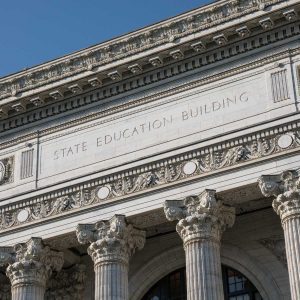The Department of Education’s Updates to the Higher Education Emergency Relief Fund (HEERF) Programs for Institutions of Higher Education
In September 2020, the Department of Education released clarifications and updates on the Student and Institution portions of the Higher Education Emergency Relief Fund (HEERF) programs. They include:
Personal Protective Equipment (PPE) is an allowable expenditure under HEERF
 Purchases to ensure the physical safety of students on campus are allowable uses of a grantee’s Institutional Portion of its allocation under section 18004(a)(1) of the CARES Act, when these costs are new or added and needed to implement “significant changes to the delivery of instruction due to the coronavirus.” This may include the reasonable costs of PPE, cleaning supplies, facility cleaning, or the purchase of items to help detect or prevent the spread of COVID-19 (e.g., thermometers, plastic barriers, or face masks). Grantees may also use these funds to make non-permanent changes to existing instructional facilities to ensure social distancing.
Purchases to ensure the physical safety of students on campus are allowable uses of a grantee’s Institutional Portion of its allocation under section 18004(a)(1) of the CARES Act, when these costs are new or added and needed to implement “significant changes to the delivery of instruction due to the coronavirus.” This may include the reasonable costs of PPE, cleaning supplies, facility cleaning, or the purchase of items to help detect or prevent the spread of COVID-19 (e.g., thermometers, plastic barriers, or face masks). Grantees may also use these funds to make non-permanent changes to existing instructional facilities to ensure social distancing.
Originally, guidance on what was allowable was broad with only a few exceptions noted:
“To cover any costs associated with significant changes to the delivery of instruction due to the coronavirus so long as such costs do not include payment to contractors for the provision of pre-enrollment recruitment activities, including marketing and advertising; endowments; or capital outlays associated with facilities related to athletics, sectarian instruction, or religious worship.”
Key Points
This new guidance highlights specific items that fall under the scope of allowable costs. The inclusion of non-permanent changes to existing instructional facilities is a constraint on how the funds can be spent that wasn’t previously spelled out. That is a limitation to keep in mind if you planned on using these funds to remodel your facility to make accommodations in response to COVID-19.
While this guidance doesn’t address IT-related costs associated with the switch to distance learning as a result of the pandemic, prior guidance from the Department in the FAQs on the matter states that:
“Institutions may use the funds for Recipient’s Institutional Costs to purchase equipment or software, pay for online licensing fees, or pay for internet service to enable students to transition to distance learning as such costs are associated with a significant change in the delivery of instruction due to the coronavirus. Additionally, institutions that purchased computers or other equipment to donate or provide to students on or after March 13, 2020, the date of the Proclamation of National Emergency, may reimburse themselves for such computers or other equipment from the funds for Recipient’s Institutional Costs.”
Be mindful that future clarification may be forthcoming and that it could expand or even contract the use of the funds as we’ve currently seen with this guidance. Make sure that any Institutional funds spent are tracked and documented as to how they relate to significant changes in the delivery of instruction due to the coronavirus.
Federal Funding Accountability and Transparency Act of 2006 (FFATA) reporting not required for HEERF
According to the Department:
“Following the Department’s July 9 statement (published as an Electronic Announcement (EA) to institutions of higher education on July 10, 2020) regarding the use of the FFATA Subaward Reporting System (FSRS) for purposes of reporting the use of HEERF funds, we received a number of questions and concerns about reporting for HEERF grantees. We have since concluded that institutions receiving HEERF formula funding will not likely have subawards and will not be able to use FSRS for reporting their use of HEERF funds.”
Key Points
The notice points out that the Department will shortly publish a new informational form to address the reporting requirement with the initial due date of October 30, 2020 for the period covering the date of the first HEERF grant award through September 30, 2020. A draft of the form can be found here.
Changes to the section 18004(a)(1) Student Aid allocation public reporting requirement
The Department released the following statement:
“The Department has recently revised our May 6 Electronic Announcement (EA) on institutional reporting for the emergency financial aid grants to students made with institutions’ allocations under section 18004(a)(1), Student Aid Portion, of the CARES Act.
This EA has been superseded by our August 31 EA found here in the Federal Register. It can also be found on our CARES Act HEERF homepage here. This revised EA, in conjunction with approved information collection under OMB control number 1801-0005, requires grantees receiving awards under section 18004(a)(1) of the CARES Act to publicly post certain grant information on the institution’s primary website as part of the reporting requirements under section 18004(e) of the CARES Act. This revised EA maintains the same seven reporting elements, but it adds a clarifying footnote for reporting item four and decreases the frequency of reporting after the initial 30-day period from every 45 days thereafter to every calendar quarter.
Grantees posting a 45-day report on or after August 31, 2020 should instead post a report every calendar quarter, with the next calendar quarter report due by October 10, 2020 and covering the period from after their last 45-day or 30-day report through the end of the calendar quarter on September 30, 2020.”
Key Points
The change to the quarterly reporting requirement should alleviate some of administrative burden with managing the grant monies.
The full release can be found here.
The Department’s clarifications may have a direct impact on your institution and how you can use HEERF funding to serve your students. Make sure your school is complying with this update and talk through your specific situation with a Title IV audit expert.





